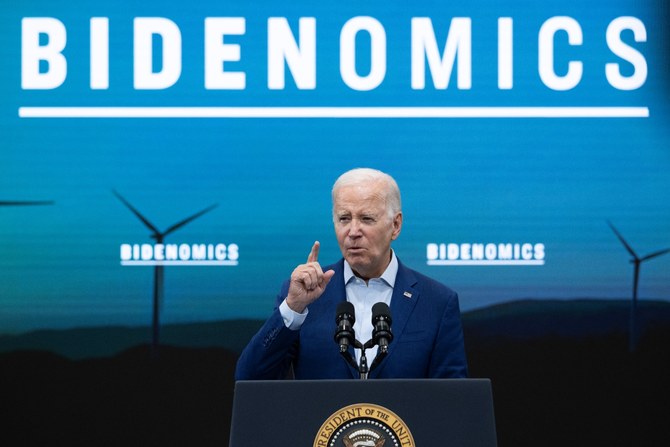Kerry Boyd Anderson
This summer, US President Joe Biden and his advisers have started promoting “Bidenomics” as a key message in his reelection campaign. It is unclear if the concept will gain traction among voters; if it does, it presents both opportunity and risk for Biden.
Bidenomics is a relatively new term that few Americans so far understand. To some extent, it is a grab bag of economic goodies – Biden’s efforts to claim credit for anything good in the economy. That is hardly unusual, as most presidents try to claim credit for economic progress while trying to avoid blame for economic problems.
However, the concept of Bidenomics is starting to take shape. Biden and his team have repeatedly emphasized building the economy “from the middle out and the bottom up.” This is a direct and intentional rejection of the classic Republican idea of trickle-down economics.
Republican economic policy has often assumed that easing regulations and taxes on wealthy Americans and large corporations will help drive investment in the broader economy and thus eventually benefit the middle and lower classes. The Trump administration’s major legislative achievement – reforming the tax system – is an example, as the largest and most permanent tax cuts went to corporations and wealthy individuals.
Democrats have long criticized this economic approach and Bidenomics explicitly takes a different approach. It is focused on using government investment in infrastructure, research and development, and expanding the social safety net in order to boost economic growth, including both public and private investment. Biden is willing to increase taxes on large corporations and the wealthy to help fund public investment, while avoiding tax increases for the middle class.
Bidenomics focuses public investment on areas that the president sees as crucial to generating economic growth that benefits most Americans. Key areas include infrastructure, semiconductors and clean energy. The White House has taken steps to try to ensure that much of that investment stays within the US, hoping to increase manufacturing jobs for Americans and reduce the country’s dependence on foreign supply chains.
Other key elements of Bidenomics include “empowering workers” through public investment in various types of education and strengthening unions, as well as steps to boost competition, including boosting efforts to enforce antitrust rules.
Biden also took a lesson from his time as vice president, when the US was trying to recover from the Great Recession. He believes that the government should have acted more quickly and with more money to fuel the recovery. In the wake of the COVID-19 crisis, he preferred to go big, including additional stimulus through the American Rescue Plan. Despite warnings that such measures could contribute to inflation, Biden chose to use fiscal tools to fuel recovery while leaving monetary measures to control inflation to the Fed. Biden and his team believe that Bidenomics worked. Since the pandemic, the US has experienced faster economic recovery than its peer economies. In the second quarter of this year, gross domestic product growth was 2.4 percent, exceeding many expectations. The inflation rate has declined and core inflation is lower than in most other advanced economies. Unemployment is about 3.5 percent, a historically low rate. The economy continues to create new jobs. Crucially, wages began to rise faster than prices in the spring for the first time in two years. The White House argues that key legislative accomplishments – notably, the 2021 American Rescue Plan, the 2021 Infrastructure Investment and Jobs Act, and the 2022 Inflation Reduction Act – have played major roles in driving economic and job growth.
There is a lot of truth in Biden’s claims about economic progress, but there is also exaggeration and selective use of data, as is typical. Republicans criticize Biden’s claims and economic policies, arguing that his policies expand government’s role in the economy and fuel inflation. However, what will really shape the 2024 election is how voters feel about the economy. The accuracy of statistics and economic claims has little to do with electoral outcomes, while public perceptions play a major role. Voters are not as driven by their wallets as many political analysts claim, but it is one important factor. Inflation is often the most poignant economic problem for voters; although the annual inflation rate has declined to 3.2 percent, Americans were shocked by the highest inflation in decades – hitting 9.1 percent in 2022 – and still feel the effects of higher prices.
The experience of inflation and other factors has led to very low approval ratings for Biden’s management of the economy. Some polls have shown a gradual improvement in public perceptions of the economy, but approval of Biden’s economic management remained around 37 percent in recent polls. A recent CNN poll also found that 51 percent of Americans believe the economy is getting worse. While economic indicators clearly suggest an improving economy with many positive elements, some of that improvement is recent and many Americans are not yet feeling it. Democrats also have to fight against a long-standing perception among many Americans that Republicans perform better on economic issues. By promoting Bidenomics, the president is placing a big bet on economic outcomes, even though any president has limited control over the economy. If Americans feel significantly better about the economy by November 2024, Bidenomics could play a major role in helping Biden win reelection. However, if Americans’ attitudes toward the economy do not improve – let alone if they worsen – the Republican Party will be sure to benefit.
Arab News







